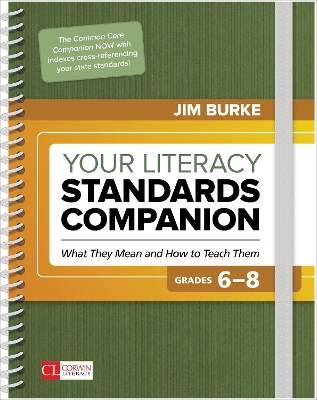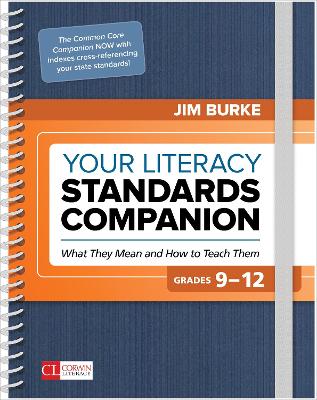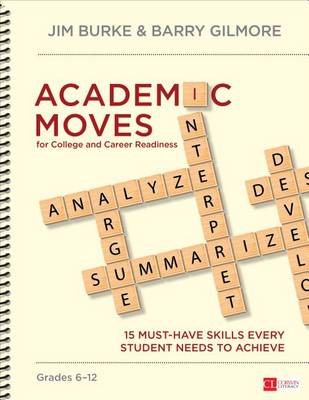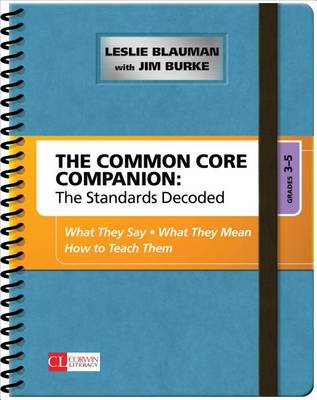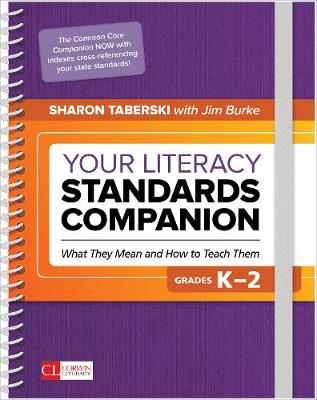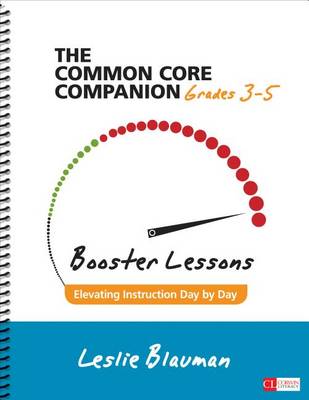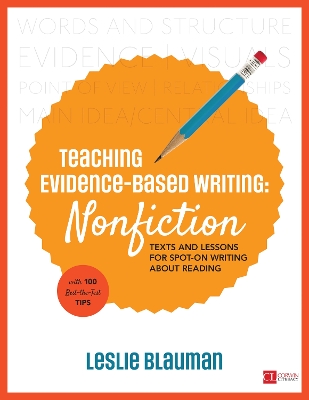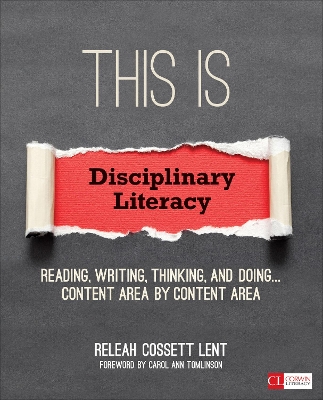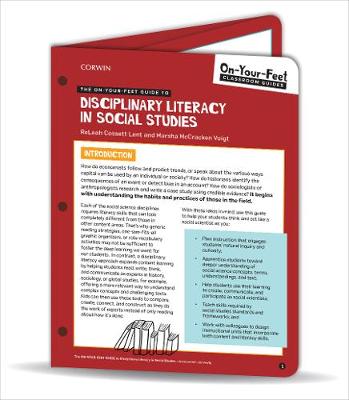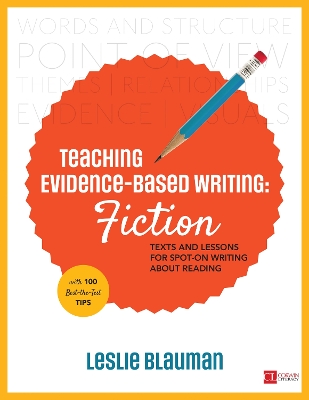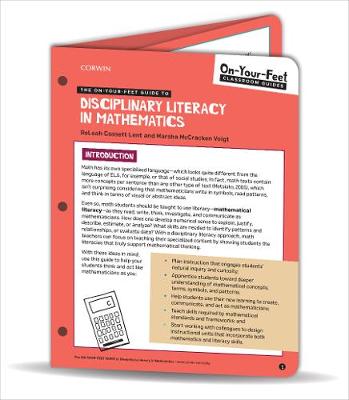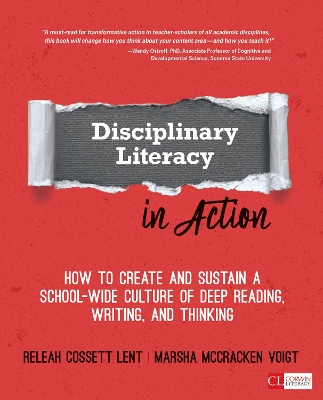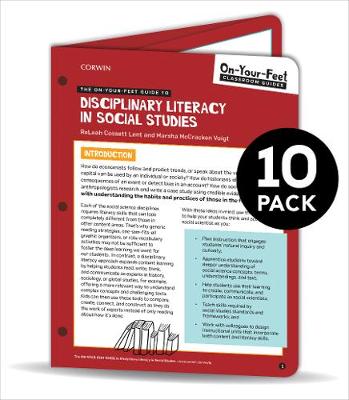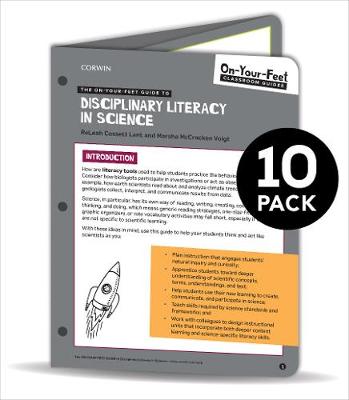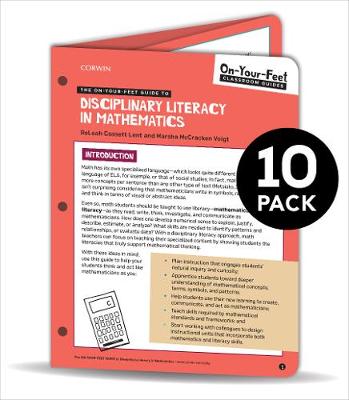Corwin Literacy
18 total works
This new version of The Common Core Companion provides an index for all states implementing state-specific ELA standards. This index allows you to see in an instant which of your standards are the same as CCSS, which differ and how-and which page number to turn to for standards-based teaching ideas.
Beyond that? It's the same great go-to guide for implementing the standards into daily practice across English Language Arts, Social Studies, Science, and Technical Subjects.
Your Literacy Standards Companion, Grades 3-5
by Leslie A. Blauman and James R. Burke
This new version of The Common Core Companion provides an index for all states implementing state-specific ELA standards. This index allows you to see in an instant which of your standards are the same as CCSS, which differ and how-and which page number to turn to for standards-based teaching ideas.
Beyond that? It's the same great go-to guide for implementing the standards, translating each and every standard for reading, writing, speaking and listening, language, and foundational skills into the day-to-day "what you do."
Academic Moves for College and Career Readiness, Grades 6-12
by James R. Burke and Barry Gilmore
Turn today's youth into innovative, ambitious thinkers with fifteen critical reading, writing, and thinking processes. Jim and Barry distill each process into a potent concision that spans subject areas.
The Common Core Companion: The Standards Decoded, Grades 3-5
by Leslie A. Blauman and James R. Burke
- Reading
- Literature
Informational Text
Foundational Reading Skills (This is a departure from the 6-12 standards that we will have to consider in design/format)
Writing
Speaking and Listening
Language
Your Literacy Standards Companion, Grades K-2
by Sharon D. Taberski and James R. Burke
The reality? The 1.3 million students who fail to graduate from high school each year and the hundreds of thousands more who either gave up or lost interest long ago . . .
The reality is why Common Core CPR is needed. Urgently. Because if we continue to insist that all students meet expectations that are well beyond their abilities and mindsets, these kids will only decline faster. We must be brave enough-and trained enough-to cast aside what we know harms students and apply with renewed vigour the teaching methods we know work.
Releah Lent and Barry Gilmore rise to the challenge, and there are no two authors better equipped to do so. They embrace what is best about the standards-their emphasis on active, authentic learning-and then explicitly show teachers how to connect these ideal outcomes to practical classroom strategies, detailing the day-to-day teaching that can coax reluctant learners into engagement and achievement. You'll learn how to:
* Consider choice and relevance in every assignment
* Plan and spot opportunities for success
* Scaffold students' comprehension of complex fiction and nonfiction texts
* Model close reading through thoughtful questioning
* Teach students to use evidence in reading, writing, speaking, and reflection
The On-Your-Feet Guide to Disciplinary Literacy in Social Studies
by ReLeah Cossett Lent and Marsha McCracken Voigt
All On-Your-Feet Guide orders receive FREE SHIPPING! Use code SHIPOYFG at check out.
Each of the social science disciplines requires literacy skills that can look completely different from those in other content areas. A disciplinary literacy approach, then, expands content learning by helping students read, write, think, and communicate as experts in history, sociology, or global studies, offering a more relevant way to understand complex concepts and challenging texts.
This On-Your-Feet Guide will help teachers
* Plan instruction that engages students' natural inquiry and curiosity;
* Apprentice students toward deeper understanding of social science concepts, terms, understandings, and text;
* Help students use their learning to create, communicate, and participate as social scientists;
* Teach skills required by social studies standards and frameworks; and
* Work with colleagues to design instructional units that incorporate both content and literacy skills.
Students can then use these tools to compare, create, connect, and construct as they do the work of experts instead of only reading about how it's done.
On-Your-Feet Guides (OYFGs) provide you with the ultimate "cheat sheet" to implement effective change in your classroom while in the moment of teaching. Designed for accessibility, and providing step-by-step guidance, the OYFGs are written by experts who take research-based practices and make them doable for the busy teacher.
Each On-Your-Feet Guide is laminated, 8.5"x11" tri-fold (6 pages), and 3-hole punched.
Use the On-Your-Feet Guides
* When you know the "what" but need help with the "how"
* As a quick reference to support a practice you learned in a PD workshop or book
* To learn how to implement foundational practices
* When you want to help your students learn a specific strategy, routine, or approach, but aren't sure how to do it yourself
The On-Your-Feet Guide to Disciplinary Literacy in Mathematics
by ReLeah Cossett Lent and Marsha McCracken Voigt
All On-Your-Feet Guide orders receive FREE SHIPPING! Use code SHIPOYFG at check out.
Math has its own specialized language. Mathematicians write in symbols, read patterns, and think in terms of visual or abstract ideas. With a disciplinary literacy approach, math teachers can focus on teaching their specialized content by showing students the literacies that truly support mathematical thinking - so students can read, write, think, investigate, and communicate as mathematicians.
This On-Your-Feet Guide will help teachers:
- Plan instruction that engages students' natural inquiry and curiosity;
- Apprentice students toward deeper understanding of mathematical concepts, terms, symbols, and patterns;
- Help students use their new learning to create, communicate, and act as mathematicians;
- Teach skills required by mathematical standards and frameworks; and
- Start working with colleagues to design instructional units that incorporate both mathematics and literacy skills.
On-Your-Feet Guides (OYFGs) provide you with the ultimate "cheat sheet" to implement effective change in your classroom while in the moment of teaching. Designed for accessibility, and providing step-by-step guidance, the OYFGs are written by experts who take research-based practices and make them doable for the busy teacher.
Each On-Your-Feet Guide is laminated, 8.5"x11" tri-fold (6 pages), and 3-hole punched.
Use the On-Your-Feet Guides
- When you know the "what" but need help with the "how"
- As a quick reference to support a practice you learned in a PD workshop or book
- To learn how to implement foundational practices
- When you want to help your students learn a specific strategy, routine, or approach, but aren't sure how to do it yourself
Disciplinary Literacy in Action
by ReLeah Cossett Lent and Marsha McCracken Voigt
BUNDLE: Lent: The On-Your-Feet Guide to Disciplinary Literacy in Social Studies: 10 Pack
by ReLeah Cossett Lent and Marsha McCracken Voigt
All On-Your-Feet Guide orders receive FREE SHIPPING! Use code SHIPOYFG at check out.
Each of the social science disciplines requires literacy skills that can look completely different from those in other content areas. A disciplinary literacy approach, then, expands content learning by helping students read, write, think, and communicate as experts in history, sociology, or global studies, offering a more relevant way to understand complex concepts and challenging texts.
This On-Your-Feet Guide will help teachers
* Plan instruction that engages students' natural inquiry and curiosity;
* Apprentice students toward deeper understanding of social science concepts, terms, understandings, and text;
* Help students use their learning to create, communicate, and participate as social scientists;
* Teach skills required by social studies standards and frameworks; and
* Work with colleagues to design instructional units that incorporate both content and literacy skills.
Students can then use these tools to compare, create, connect, and construct as they do the work of experts instead of only reading about how it's done.
On-Your-Feet Guides (OYFGs) provide you with the ultimate "cheat sheet" to implement effective change in your classroom while in the moment of teaching. Designed for accessibility, and providing step-by-step guidance, the OYFGs are written by experts who take research-based practices and make them doable for the busy teacher.
Each On-Your-Feet Guide is laminated, 8.5"x11" tri-fold (6 pages), and 3-hole punched.
Use the On-Your-Feet Guides
* When you know the "what" but need help with the "how"
* As a quick reference to support a practice you learned in a PD workshop or book
* To learn how to implement foundational practices
* When you want to help your students learn a specific strategy, routine, or approach, but aren't sure how to do it yourself
The On-Your-Feet Guide to Disciplinary Literacy in Science
by ReLeah Cossett Lent and Marsha McCracken Voigt
All On-Your-Feet Guide orders receive FREE SHIPPING! Use code SHIPOYFG at check out.
How can you use literacy tools used to help students practice the behaviors of scientists? With a disciplinary literacy approach, science teachers can focus on teaching their specialized content by showing students the literacies that truly support scientific thinking - so students can read, write, think, investigate, and communicate as scientists.
This On-Your-Feet Guide will help teachers:INTRODUCTION
* Plan instruction that engages students' natural inquiry and curiosity;
* Apprentice students toward deeper understanding of scientific concepts, terms, understandings, and text;
* Help students use their new learning to create, communicate, and participate in science;
* Teach skills required by science standards and frameworks; and
* Work with colleagues to design instructional units that incorporate both deeper content learning and science-specific literacy skills.
The strategies in this guide will help you teach students to read, write, think, and do as scientists!
On-Your-Feet Guides (OYFGs) provide you with the ultimate "cheat sheet" to implement effective change in your classroom while in the moment of teaching. Designed for accessibility, and providing step-by-step guidance, the OYFGs are written by experts who take research-based practices and make them doable for the busy teacher.
Each On-Your-Feet Guide is laminated, 8.5"x11" tri-fold (6 pages), and 3-hole punched.
Use the On-Your-Feet Guides
* When you know the "what" but need help with the "how"
* As a quick reference to support a practice you learned in a PD workshop or book
* To learn how to implement foundational practices
* When you want to help your students learn a specific strategy, routine, or approach, but aren't sure how to do it yourself
BUNDLE: Lent: The On-Your-Feet Guide to Disciplinary Literacy in Science: 10 Pack
by ReLeah Cossett Lent and Marsha McCracken Voigt
All On-Your-Feet Guide orders receive FREE SHIPPING! Use code SHIPOYFG at check out.
How can you use literacy tools used to help students practice the behaviors of scientists? With a disciplinary literacy approach, science teachers can focus on teaching their specialized content by showing students the literacies that truly support scientific thinking - so students can read, write, think, investigate, and communicate as scientists.
This On-Your-Feet Guide will help teachers:INTRODUCTION
* Plan instruction that engages students' natural inquiry and curiosity;
* Apprentice students toward deeper understanding of scientific concepts, terms, understandings, and text;
* Help students use their new learning to create, communicate, and participate in science;
* Teach skills required by science standards and frameworks; and
* Work with colleagues to design instructional units that incorporate both deeper content learning and science-specific literacy skills.
The strategies in this guide will help you teach students to read, write, think, and do as scientists!
On-Your-Feet Guides (OYFGs) provide you with the ultimate "cheat sheet" to implement effective change in your classroom while in the moment of teaching. Designed for accessibility, and providing step-by-step guidance, the OYFGs are written by experts who take research-based practices and make them doable for the busy teacher.
Each On-Your-Feet Guide is laminated, 8.5"x11" tri-fold (6 pages), and 3-hole punched.
Use the On-Your-Feet Guides
* When you know the "what" but need help with the "how"
* As a quick reference to support a practice you learned in a PD workshop or book
* To learn how to implement foundational practices
* When you want to help your students learn a specific strategy, routine, or approach, but aren't sure how to do it yourself
BUNDLE: Lent: The On-Your-Feet Guide to Disciplinary Literacy in Math: 10 Pack
by ReLeah Cossett Lent and Marsha McCracken Voigt
All On-Your-Feet Guide orders receive FREE SHIPPING! Use code SHIPOYFG at check out.
Math has its own specialized language. Mathematicians write in symbols, read patterns, and think in terms of visual or abstract ideas. With a disciplinary literacy approach, math teachers can focus on teaching their specialized content by showing students the literacies that truly support mathematical thinking - so students can read, write, think, investigate, and communicate as mathematicians.
This On-Your-Feet Guide will help teachers:
- Plan instruction that engages students' natural inquiry and curiosity;
- Apprentice students toward deeper understanding of mathematical concepts, terms, symbols, and patterns;
- Help students use their new learning to create, communicate, and act as mathematicians;
- Teach skills required by mathematical standards and frameworks; and
Start working with colleagues to design instructional units that incorporate both mathematics and literacy skills.On-Your-Feet Guides (OYFGs) provide you with the ultimate "cheat sheet" to implement effective change in your classroom while in the moment of teaching. Designed for accessibility, and providing step-by-step guidance, the OYFGs are written by experts who take research-based practices and make them doable for the busy teacher.
Each On-Your-Feet Guide is laminated, 8.5"x11" tri-fold (6 pages), and 3-hole punched.
Use the On-Your-Feet Guides
- When you know the "what" but need help with the "how"
- As a quick reference to support a practice you learned in a PD workshop or book
- To learn how to implement foundational practices
- When you want to help your students learn a specific strategy, routine, or approach, but aren't sure how to do it yourself
